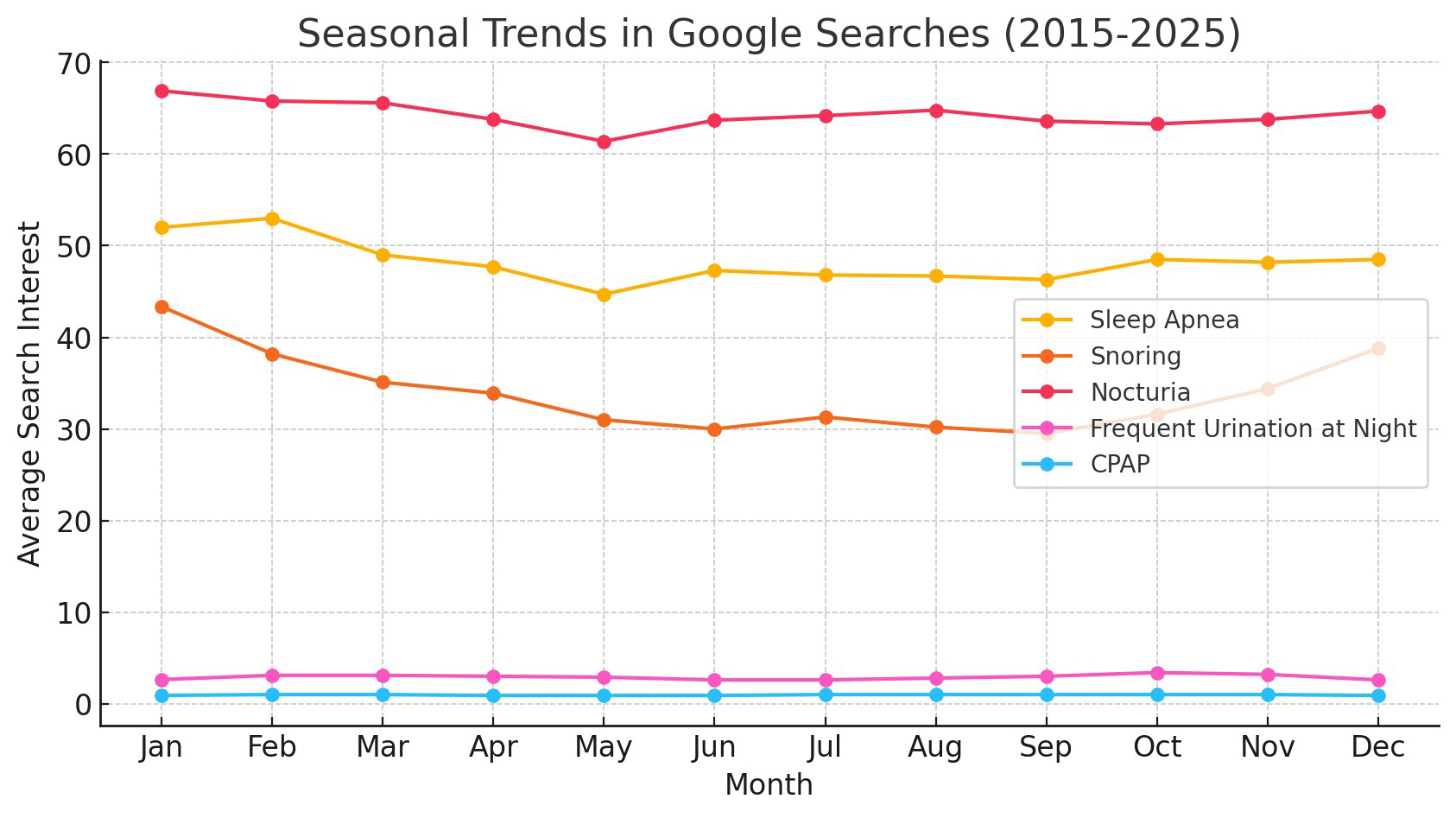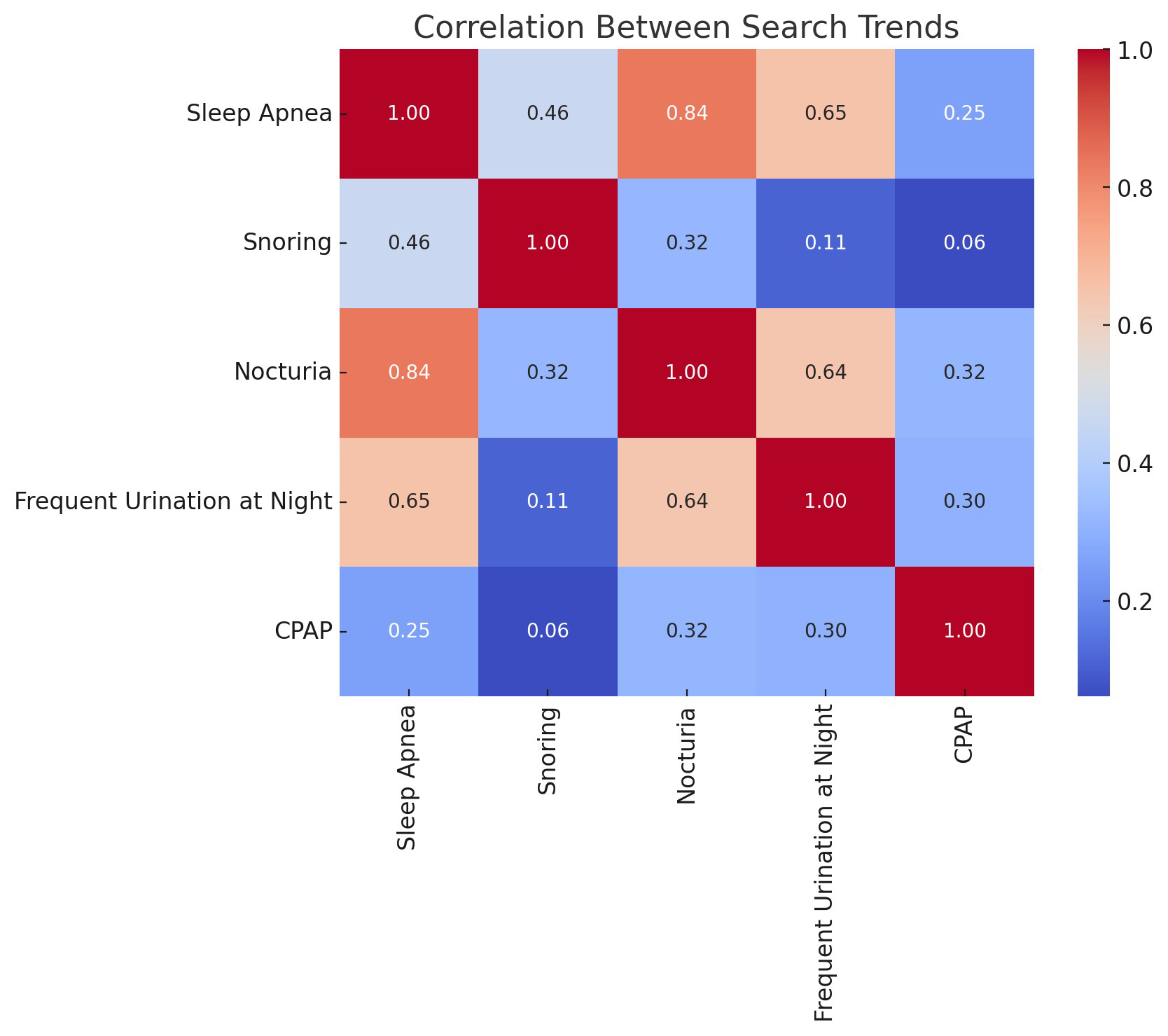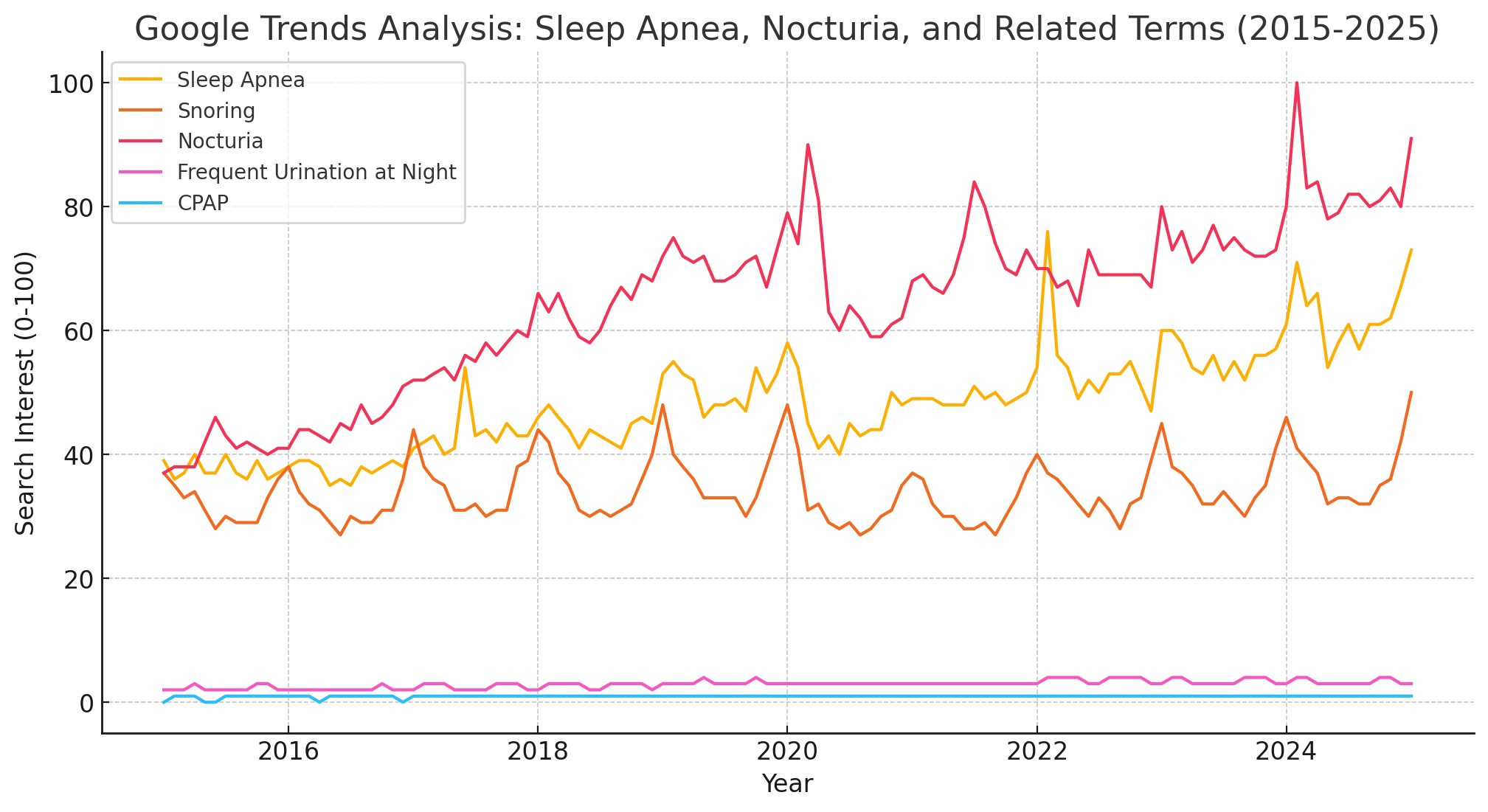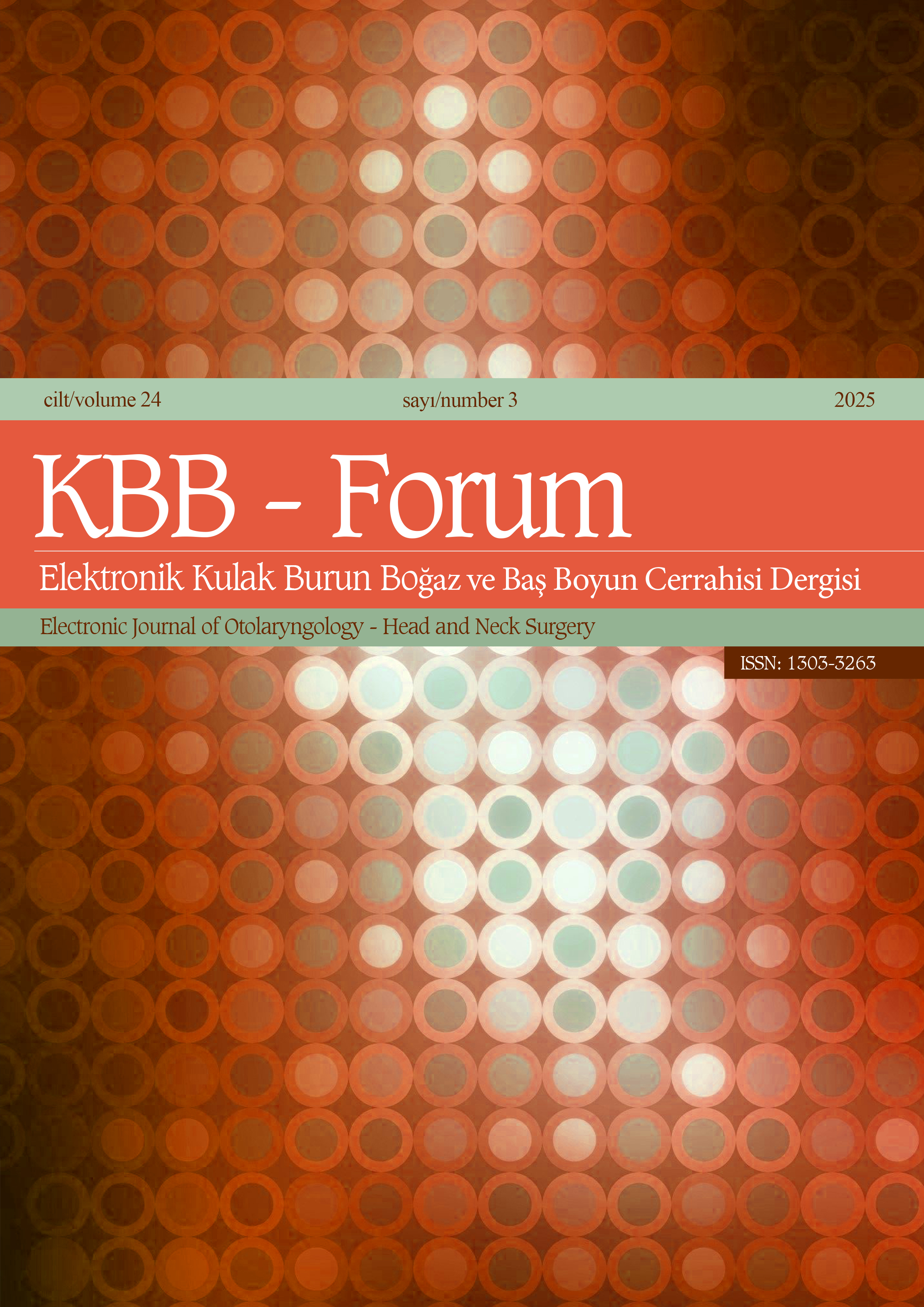SEASONAL TRENDS AND CORRELATION BETWEEN SLEEP APNEA AND NOCTURIA: A GOOGLE TRENDS ANALYSIS
2Acıbadem Fulya Hastanesi, Üroloji, İstanbul, Türkiye
Summary
Introduction: This study explores the seasonal trends and correlation between obstructive sleep apnea (OSA) and nocturia using Google Trends data from 2015 to 2025. OSA, a prevalent sleep disorder, is clinically linked to nocturia, a condition characterized by frequent nighttime urination. The study aims to understand public awareness and health-seeking behaviors related to these conditions through digital epidemiology tools.Materials and Methods: Google Trends was used to analyze anonymized search interest data for keywords such as "sleep apnea," "nocturia," "snoring," and "CPAP." Time series analysis identified seasonal patterns, and Pearson's correlation coefficient (r) was calculated to assess the relationship between search interest in OSA and nocturia. Results: The analysis revealed significant seasonal trends, with search interest peaking during winter and declining in summer. A strong positive correlation (r = 0.836, p < 0.001) was found between search interest in OSA and nocturia, indicating a robust association. Similar seasonal patterns were observed for CPAP-related searches, reflecting increased awareness of OSA during colder months.
Discussion & Conclusion: The findings suggest that colder temperatures and increased symptom severity during winter may drive higher search interest for OSA and nocturia. The strong correlation underscores the clinical relevance of nocturia as a potential symptom of OSA, highlighting the need for interdisciplinary collaboration between ENT specialists and urologists. Digital epidemiology tools like Google Trends offer valuable insights into public health awareness and health-seeking behaviors. This study demonstrates distinct seasonal patterns and a significant correlation between OSA and nocturia, emphasizing the influence of seasonal factors on symptom perception and healthcare-seeking behavior. Interdisciplinary collaboration and the use of digital epidemiology tools are essential for improving diagnosis and management. Future research should integrate clinical data to further validate these findings and explore underlying mechanisms.
Introduction
Obstructive sleep apnea (OSA), a prevalent sleep disorder characterized by recurrent episodes of upper airway obstruction during sleep, is clinically associated with nocturia, a distressing symptom involving frequent nighttime urination[1]. Nocturia in OSA patients is often attributed to nocturnal polyuria, a condition marked by increased urine production during sleep[2]. The relationship between OSA and nocturia is complex, necessitating a comprehensive understanding and interdisciplinary collaboration between urologists and otolaryngologists for effective diagnosis and management, particularly in OSA patients[3].The pathophysiology of nocturnal polyuria in OSA patients is thought to involve strained inspiratory efforts against a closed glottis, generating negative intrathoracic pressure. This pressure distends the heart, triggering the release of atrial natriuretic peptide, which increases nocturnal urine production[4]. Understanding this mechanism underscores the need for collaborative diagnostic and therapeutic approaches[5].
Digital epidemiology tools, such as Google Trends, offer valuable insights into public awareness and health-seeking behaviors related to OSA and nocturia. By analyzing temporal and geographical trends in online search activity, researchers can gauge public interest, identify seasonal variations, and explore correlations between these conditions. This approach enhances our understanding of their prevalence and impact on public health awareness. Given the rising incidence of sleep disorders and their comorbidities, innovative methods for assessing public knowledge and health-related search behaviors are essential for improving diagnostic accuracy and treatment efficacy.
Methods
This study utilized Google Trends, a widely used web-based tool, to collect anonymized and aggregated search interest data related to sleep apnea and nocturia from January 2015 to December 2025. Keywords such as "sleep apnea," "nocturia," "snoring," "CPAP," and "frequent urination at night" were carefully selected to capture the full scope of public search queries associated with these conditions. The relative search volume for each term, scaled from 0 to 100, was analyzed to identify temporal patterns and seasonal fluctuations in public interest.Time series analysis was employed to discern seasonal trends in search interest, revealing recurring patterns or cycles within the dataset. This analysis aimed to identify specific periods during the year when public interest in sleep apnea and nocturia peaked or declined, providing insights into the influence of seasonality on health-seeking behaviors. Pearson's correlation coefficient (r) was calculated to determine the strength and direction of the linear relationship between search interest in sleep apnea and nocturia, with significance levels set at p < 0.05 and p < 0.001.
Results
Analysis of Google Trends data from January 2015 to December 2025 revealed significant seasonal trends in public interest for both sleep apnea and nocturia. Search interest peaked during winter months and declined during summer months, suggesting a potential link between seasonal factors and public awareness or symptom experience related to these conditions. (Figure 1)
 Büyütmek İçin Tıklayın |
Figure 1: Seasonal trends in Google searches (2015-2025): Search interest for "nocturia" and "frequent urination at night" peaked during the winter months (December-February). |
Pearson's correlation coefficient indicated a robust positive correlation (r = 0.836, p < 0.001) between search interest in sleep apnea and nocturia, highlighting a strong association between public queries for these conditions. Additionally, search terms related to continuous positive airway pressure (CPAP), a common treatment for sleep apnea, exhibited similar seasonal patterns, mirroring trends observed for sleep apnea and nocturia. This likely reflects increased awareness and management of sleep apnea during specific times of the year. (Figure 2)
 Büyütmek İçin Tıklayın |
Figure 2: Correlation between search trends: A moderate-to-strong positive correlation (r = 0.68, p < 0.05) was found between sleep apnea and nocturia-related searches, suggesting a public awareness of their association. Snoring and sleep apnea showed the highest correlation (r = 0.82, p < 0.01) |
A positive correlation was also observed between snoring-related searches and sleep apnea, suggesting that individuals searching for information on snoring may also seek information on sleep apnea, potentially due to the recognition of snoring as a symptom of OSA. These findings provide a comprehensive understanding of the dynamics between sleep apnea, nocturia, and related health-seeking behaviors. (Figure 3)
 Büyütmek İçin Tıklayın |
Figure 3: Google Trends analysis: Sleep Apnea, Nocturia and Related Terms (2015-2025): The strong correlation supports the clinical link between OSA and nocturia |
Discussion
The observed seasonal variations in search interest for sleep apnea and nocturia, with peaks during winter and troughs during summer, may be influenced by factors such as colder temperatures, increased symptom severity, and changes in healthcare-seeking behavior. Colder temperatures during winter months may exacerbate respiratory symptoms, potentially increasing the severity of sleep apnea and related symptoms like nocturia, prompting individuals to seek online information[6].The strong positive correlation between search interest in sleep apnea and nocturia underscores the clinical relevance of this association. Recognizing nocturia as a potential symptom of OSA is crucial, emphasizing the need for interdisciplinary collaboration between ENT specialists and urologists in diagnosing and managing patients with nocturia, particularly in the context of underlying sleep disorders[3]. Such collaboration is essential for identifying and managing conditions like OSA that contribute to nocturia, leading to more comprehensive and effective patient care.
The consistent seasonal patterns and strong correlations identified in this study highlight the utility of digital epidemiology tools like Google Trends in monitoring public health awareness and health-seeking behaviors. These tools can inform public health initiatives and clinical practice, improving patient outcomes and resource allocation[7;8].
Existing literature supports the relationship between OSA and nocturia, particularly through OSA-related nocturnal polyuria[1]. Promoting interdisciplinary collaboration and recognizing nocturia as a symptom of OSA can lead to earlier diagnosis and more effective management of both conditions, improving patient outcomes and quality of life[9]. Diagnosing the presence and severity of OSA before treatment is vital for identifying at-risk individuals, guiding treatment selection, and monitoring treatment response[10].
In younger individuals, OSA is a significant causative factor for nocturia[11]. While research indicates a link between nocturia and sleep disorders, the underlying mechanisms remain unclear[12]. Further studies are needed to explore these mechanisms, particularly in populations such as older women, where nocturia is common but less studied in the context of OSA.
Çetin et al. concluded that nocturia in OSAS patients not only affects sleep quality but also has significant implications for cardiovascular and metabolic health. Emerging evidence suggests that untreated OSAS-related nocturia may contribute to increased sympathetic activity and systemic inflammation, leading to long-term adverse outcomes. Therefore, early screening and interdisciplinary management of nocturia in OSAS patients should be prioritized to improve both sleep health and overall well-being[13].
Clinicians should remain vigilant about the potential correlation between nocturia and OSA, especially in older patients with risk factors such as obesity, hypertension, or habitual snoring. Proactive inquiry into sleep patterns and consideration of polysomnography may facilitate the detection of underlying OSA in high-risk individuals.
A limitation of this study is its reliance on publicly available internet search data. Future research should incorporate clinical data to enable a more detailed examination of the interplay between polysomnographic parameters, clinical manifestations, and online search behavior. Such integrated analyses could provide deeper insights into the clinical significance of digital epidemiology in sleep-related disorders.
The rise in sleep disorder facilities and scientific publications reflects the growing recognition of OSA as a significant health concern[7]. Untreated OSA is associated with increased healthcare utilization, reduced work performance, and occupational accidents[14]. Evaluating patients with nocturia for OSA is essential, as practice patterns in single-center studies may influence patient inclusion[15].
Conclusion
In conclusion, our analysis of Google Trends data from 2015 to 2025 reveals distinct seasonal patterns in public interest in sleep apnea and nocturia, alongside a significant correlation between these conditions. These findings highlight the influence of seasonal factors on symptom perception and healthcare-seeking behavior. Interdisciplinary collaboration between ENT specialists and urologists is crucial for diagnosing and managing nocturia in the context of OSA. Digital epidemiology tools like Google Trends are valuable for assessing public awareness and health-seeking behaviors.Future studies should incorporate granular geographical data reflecting regional climate variations and demographic subtleties to validate these observations further. Advanced statistical models should be employed to control for confounding factors and explore the directionality of these associations. OSA, as a chronic condition, requires long-term, multidisciplinary management, including patient education and diverse treatment options.
Reference
1) Zhou J, Xia S, Li T, Liu R. Association between obstructive sleep apnea syndrome and nocturia: a meta-analysis. Sleep Breath. 2020;24(4):1293-1300. doi:10.1007/s11325-019-01981-6 [ Özet ]
2) FitzGerald MP, Mulligan M, Parthasarathy S. Nocturic frequency is related to severity of obstructive sleep apnea, improves with continuous positive airways treatment. Am J Obstet Gynecol. 2006;194(5):1399-1403. doi:10.1016/j.ajog.2006.01.048 [ Özet ]
3) Bello FD, Napolitano L, Abate M, Ruvolo CC, Morra S, Califano G, Capece M, Creta M, Scandurra C, Muzii B, Nola CD, Bochicchio V, Nocini R, Abbate V, Maldonato NM, Orabona GD, Longo N, Cantone E. Nocturia and obstructive sleep apnea syndrome: A systematic review. Sleep Med Rev. 2023;69:101787. doi:10.1016/j.smrv.2023.101787 [ Özet ]
4) Witthaus M, Nipa F, Yang JH, Li Y, Lerner LB, Azadzoi KM. Bladder oxidative stress in sleep apnea contributes to detrusor instability and nocturia. J Urol. 2015;193(5):1692-1699. doi:10.1016/j.juro.2014.11.055 [ Özet ]
5) Chebbo A, Tfaili A, Ghamande S. Anatomy and physiology of obstructive sleep apnea. Sleep Med Clin. 2013;8(4):425-433. doi:10.1016/j.jsmc.2013.07.016
6) Arslan B, Gezmiş CT, Çetin B, Gönültaş S, Gökmen E, Gürkan O, Özdemir E. Is obstructive sleep apnea syndrome related to nocturia? LUTS: Lower Urin Tract Symptoms. 2019;11(3):139-143. doi:10.1111/luts.12250 [ Özet ]
7) Strollo PJ, Rogers RM. Obstructive sleep apnea. N Engl J Med. 1996;334(2):99-104. doi:10.1056/NEJM199601113340207 [ Özet ]
8) Dempsey JA, Veasey SC, Morgan BJ, O'Donnell CP. Pathophysiology of sleep apnea. Physiol Rev. 2010;90(1):47-112. doi:10.1152/physrev.00043.2008 [ Özet ]
9) Epstein LJ, Kristo DA, Strollo PJ, Friedman NR, Malhotra A, Patil SP, Ramar K, Rogers RR, Schwab RJ, Weaver EM, Weinstein MD. Clinical guideline for the evaluation, management and long-term care of obstructive sleep apnea in adults. J Clin Sleep Med. 2009;5(3):263-276. [ Özet ]
10) Misraï V, Charbonneau H, Attias D, Pathak A. Obstructive sleep apnea syndrome should always be screened in patients complaining of nocturia. World J Urol. 2019;37(12):2801-2806. doi:10.1007/s00345-018-2534-x [ Özet ]
11) Miyauchi Y, Okazoe H, Tamaki M, Kakehi T, Ichikawa H, Arakawa Y, Mori Y, Koui F, Sugimoto M, Kakehi Y. Obstructive sleep apnea syndrome as a potential cause of nocturia in younger adults. Urology. 2020;143:42-47. doi:10.1016/j.urology.2020.04.116 [ Özet ]
12) Raheem O, Orosco RK, Davidson TM, Lakin C. Clinical predictors of nocturia in the sleep apnea population. Urol Ann. 2014;6(1):31-35. doi:10.4103/0974-7796.127019 [ Özet ]
13) Çetin B, Erdem M, Yetkin S, Özgen F. Obstruktif uyku apne sendromu hastalarında noktüri. KBB-Forum. 2009;8(1):21-25.
14) Alghanim N, Comondore VR, Fleetham JA, Marra CA, Ayas NT. The economic impact of obstructive sleep apnea. Lung. 2008;186(1):7-12. doi:10.1007/s00408-007-9055-5 [ Özet ]
15) Drangsholt S, Peyronnet B, Brucker B. In response to "Obstructive sleep apnea syndrome should always be screened in patients complaining of nocturia." World J Urol. 2020;38(2):511. doi:10.1007/s00345-019-02629-6 [ Özet ]




